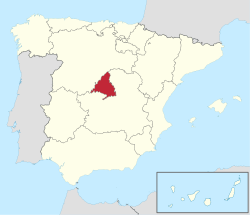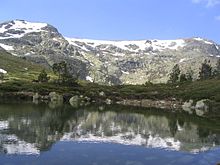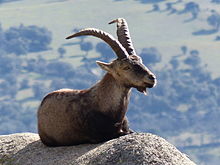Community of Madrid Comunidad de Madrid | |
|---|---|
| Anthem: "Himno de la Comunidad de Madrid" "Anthem of the Community of Madrid" | |
 Location of the Community of Madrid within Spain | |
| Coordinates: 40°30′N 3°40′WCoordinates: 40°30′N 3°40′W | |
| Country | Spain |
| Capital | City of Madrid |
| Government | |
| • President | Isabel Díaz Ayuso (PP) |
| • Legislature | Assembly of Madrid |
| • Executive | Government of the Community of Madrid |
| Area | |
| • Total | 8,028.19 km2 (3,099.70 sq mi) |
| Ranked 12th, 1.6% of Spain | |
| Population (2019) | |
| • Total | 6,661,949 |
| • Density | 829.62/km2 (2,148.7/sq mi) |
| • Pop. rank | 3rd |
| • Percent | 14.2% of Spain |
| Demonym | Madrilenian • Madrilene madrileño • madrileña |
| GDP (PPA; 2021) | |
| • Per capita | €47,041 |
| ISO 3166-2 | ES-MD |
| Official languages | Spanish |
| Statute of Autonomy | 1 March 1983 |
| HDI (2018) | 0.941[2] very high · 1st |
| Congress seats | 37 (of 350) |
| Senate seats | 11 (of 265) |
| Website | comunidad.madrid |
The Community of Madrid (Spanish: Comunidad de Madrid [komuniˈðað ðe maˈðɾið] (![]() listen)) is one of the seventeen autonomous communities of Spain. It is located in the centre of the Iberian Peninsula, and of the Central Plateau (Meseta Central). Its capital and largest municipality is the City of Madrid, which is also the capital of the country. The Community of Madrid is bounded to the south and east by Castilla–La Mancha and to the north and west by Castile and León. It was formally created in 1983, based on the limits of the province of Madrid, which was until then conventionally included in the historical region of New Castile.
listen)) is one of the seventeen autonomous communities of Spain. It is located in the centre of the Iberian Peninsula, and of the Central Plateau (Meseta Central). Its capital and largest municipality is the City of Madrid, which is also the capital of the country. The Community of Madrid is bounded to the south and east by Castilla–La Mancha and to the north and west by Castile and León. It was formally created in 1983, based on the limits of the province of Madrid, which was until then conventionally included in the historical region of New Castile.
The Community of Madrid is the third most populous in Spain with 6,661,949 (2019) inhabitants mostly concentrated in the metropolitan area of Madrid.[3] It is also the most densely populated autonomous community. In absolute terms, Madrid's economy has been, since 2018, slightly bigger in size than that of Catalonia.[4] Madrid has the highest GDP per capita in the country.[5]
It contains three World Heritage Sites: the Monastery and Royal Site of El Escorial, the University and historic centre of Alcalá de Henares, and the cultural landscape of Aranjuez. In addition, the Montejo Beech Forest is part of the transnational Ancient and Primeval Beech Forests of the Carpathians and Other Regions of Europe world heritage site.
Geography[edit]
Despite the existence of a large city of 5 million people, the Community of Madrid still retains some remarkably unspoiled and diverse habitats and landscapes. Madrid is home to mountain peaks rising above 2,000 m, holm oak dehesas and low-lying plains. The slopes of the Guadarrama mountain range are cloaked in dense forests of Scots pine and Pyrenean oak. The Lozoya Valley supports a large black (monk) vulture colony, and one of the last bastions of the Spanish imperial eagle in the world is found in the Park Regional del Suroeste in dehesa hills between the Gredos and Guadarrama ranges. The recent possible detection of the existence of Iberian lynx in the area between the Cofio and Alberche rivers is testament to the biodiversity of the area. Taking advantage of the orography, there are several reservoirs and local dams, with the Santillana reservoir being the largest.
When looking at a map of the Province of Madrid, it can be seen that it is almost an equilateral triangle, in whose center would be the city. First, by the western side, it borders the "Sistema Central" (the Guadarrama mountain range), the southern border features a protrusion following the Tagus River in order to include the royal site of Aranjuez in the region; the eastern edge of the triangle comes from the rupture of the fluvial river basins. This autonomous community is located in the basin of the Tagus River. The Tagus passes through the southern border of the Autonomy in its path west toward the Atlantic Ocean, draining the waters of the Jarama River (collecting in turn the waters of the Lozoya, the Guadalix, the Manzanares, the Henares and the Tajuña), the Alberche and the Guadarrama in the Community.[6]
This autonomous community also includes the exclave of Dehesa de la Cepeda (part of the municipality of Santa María de la Alameda), a mostly open-area geographically located between the provinces of Ávila and Segovia in the autonomous community of Castile and León.
Province of Madrid occupies a surface area of approximately 8,028 km2 (3,100 sq mi) (1.6% of all Spanish territory). More specifically, the exact position of Madrid is 3° 40´ of longitude west of Greenwich, England, and 40° 23´ north of the equator.
Most of province lies between 600 and 1,000 m above sea level. However, there the altitude ranges from the 2,428 metres of Peñalara and the 430 metres of the Alberche river when it leaves Villa del Prado into the province of Toledo.[7] Other considerable heights, as well as being famous, are the Bola del Mundo ("Ball of the World") in Navacerrada, at a height of 2,258 m, the Siete Picos ("Seven Peaks") in Cercedilla, at 2,138 m, and the Peña Cebollera (2,129 m) at the northernmost end of the province, a tripoint between the Madrid region and the provinces of Segovia and Guadalajara.
- Fauna
Among the protected species of birds nesting in the region stand out the Spanish imperial eagle, the golden eagle, the Bonelli's eagle, the cinereous vulture, the peregrine falcon and the black stork.[8]
Exotic invasive species of birds and mammals in the region include the red-eared slider, the monk parakeet, the common snapping turtle, the rose-ringed parakeet, the American mink and the raccoon.[9] Species described as "out of place" and with an increasing population include the black-headed gull, the lesser black-backed gull, the great cormorant and Eurasian collared dove,[10] while the emblematic iberian ibex is presented as a case of a species "gone out of control" in La Pedriza following its re-introduction in the region in 1990 after roughly a century disappeared from the Madrilenian mountains.[11]
The mountain amphibians living at a high altitude include the fire salamander, the marbled newt, the alpine newt, the iberian frog, the European tree frog or the common midwife toad.[12] At a middle elevation in the mountain reaches close to water streams there are species such as the Bosca's newt, the southern marbled newt, the mediterranean tree frog or the iberian midwife toad.[13] The common parsley frog and the Alytes obstetricans pertinax dwell in the limestone lowlands near the Tagus in the south-east of the region.[13] Among the all-around amphibians adaptable to different heights stand out the natterjack toad, the common toad and the iberian green frog.[13] Other species with a wide distribution range (although in this case restricted by altitude) are the gallipato, the iberian spadefoot toad, the iberian painted frog, and the Spanish painted frog.[13]
You received this message because you are subscribed to the Google Groups "1top-oldtattoo-2" group.
To unsubscribe from this group and stop receiving emails from it, send an email to 1top-oldtattoo-2+unsubscribe@googlegroups.com.
To view this discussion on the web visit https://groups.google.com/d/msgid/1top-oldtattoo-2/CAHT5888LEi7FnM3-8eMz2aD35Gf1%2B8jXacLgV0smZ-MtuAVouw%40mail.gmail.com.







No comments:
Post a Comment